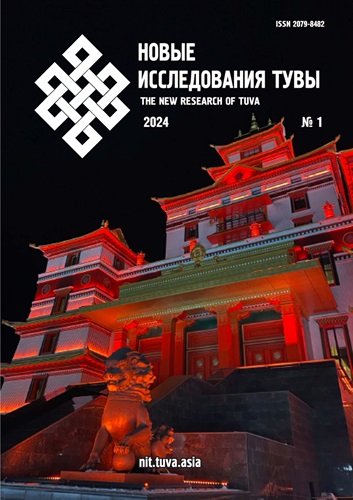Ecological ethics in Buddhism: traditions and modern experience
DOI:
https://doi.org/10.25178/nit.2024.1.16Keywords:
Buddhism; ecology; Eco-Buddhism; ecological ethics; ahimsa; doctrine of interdependence; 14th Dalai Lama; Buddhist ecological movement; Buddhism in RussiaAbstract
The article explores the specifics of ecological ethics in Buddhism. The discourse related to the phenomenon of Eco-Buddhism is examined, and the attitude towards nature in traditional Buddhism is investigated. The views of contemporary Buddhists on ecological issues are analyzed, along with Buddhist ecological movements and organizations. The ecological activities of Buddhist clergy in Russia are also highlighted.
The research is based on two groups of sources. The first group includes ancient Buddhist texts containing elements of ecological ethics. The second group comprises works by modern Buddhist thinkers. Many contemporary Buddhologists and Buddhist activists believe that Buddhism has significant potential to address modern ecological problems. In their works, a new theoretical dimension of Buddhist tradition, known as Eco-Buddhism, emerges. However, there are more skeptical perspectives on this matter. Critics of Eco-Buddhism emphasize that traditional Buddhism primarily serves soteriological goals and that attempts to environmentalize it distort historical traditions and doctrinal principles.
Nevertheless, even acknowledging a certain reinterpretation and modification of Buddhist teachings does not negate the fact that Eco-Buddhism's ideas align with the spirit and fundamental principles of Buddhist worldview. Analyzing crucial tenets of Buddhism, such as the doctrine of interdependence, karma, non-violence (ahimsa), and compassion, reveals a serious ecological potential, indicating the existence of Buddhist ecological ethics.
Today, many Buddhists actively participate in environmental conservation efforts, drawing on the ecological principles of Buddhist tradition. Significant contributions to environmental preservation are made by authoritative Buddhist leaders, particularly His Holiness the 14th Dalai Lama. The activities of Buddhist clergy in Buryatia, Kalmykia, and Tuva are noteworthy, as they engage in ecological actions and work towards fostering ecological awareness among the local population.
References
Abaev, N. V. and Opei-ool, U. P. (2009) Tengrism, Buddhism and ecological cults in Central Asia and Trans-Sayania. Kyzyl, Tipografiia KTsO «Anyiak». 144 p. (In Russ.).
Abaev, N. V. and Fel'dman, V. R. (2007) Ethno-confessional traditions and ecological culture of the peoples of Central Asia and the Altai-Baikal region. 2nd ed. Kyzyl, TuvSU Publ. 115 p. (In Russ.).
Alekseeva, N. N. (2005) Ecological aspects of socio-cultural traditions of India. In: Ethnoecological aspects of spiritual culture / ed. by V. I. Kozlov, A. N. Iamskov and N. I. Grigulevich. Moscow, IEiA RAN. 324 p. Pp. 81–101. (In Russ.).
Arakchaa, L. K. (2015) Ethnoecology of Tuva / ed. by S. S. Kurbatskaia. Kyzyl, TuvGU; TuvIKOPR SO RAN. 162 p. (In Russ.).
Baidarov, E. U. (2011) Ecological aspect of the culture of nomads of Eurasia. New Research of Tuva, no. 4, pp. 117–123. (In Russ.).
Beliaeva-Savchuk, V. A. (2015) Buddhist influence on the modern cult of mountains among the Tunka Buryats. In: The Teachings of Buddha in Russia: 250 years of the Institute of Pandito Hambo Lamas / ed. by A. V. Zorin. St. Petersburg, Tsentr «Peterburgskoe vostokovedenie». 186 p. Pp. 37–47. (In Russ.).
Bosenko, E. A. and Khan, N. R. (2023) Buddhism's teachings on ecology. Vestnik Kyrgyzsko-Rossiiskogo Slavianskogo universiteta, vol. 23, no. 2, pp. 14–18. (In Russ.).
Grechishkina, S. V. (2015) Formation of a philosophical concept based on Buddhist and Taoist views. Vestnik Tomskogo gosudarstvennogo universiteta, no. 398, pp. 30–34. (In Russ.). DOI: https://doi.org/10.17223/15617793/398/4
Gupta, P. (2019) Ethics in aesthetics: eco-spiritual symbolism in thangka painting. Iskusstvo Evrazii, no. 4(15), pp. 86–140.
Dagylga: Tuvan rites of consecration in the 21st century (2021) / ed. by Ch. K. Lamazhaa and N. D. Suvandii. Kyzyl, s. n. 188 p. (In Russ. and Tuv.). (In Russ.).
Dondukov, B. Ts. (2020) Environmental initiatives of Buddhist figures of Buryatia: current problems, local solutions. Desertum Magnum: studia historica, no. 2, pp. 122‒131. (In Russ.).
Dondukov, B. Ts. (2022) Initiatives of the Central Khurul Aimed at Improving the Environmental Situation in the Republic of Kalmykia. Kunstkamera, no. 4(18), pp. 58–66. (In Russ.). DOI: https://doi.org/10.31250/2618-8619-2022-4(18)-58-66
Dorzhigushaeva, O. V. (2013) Environmental ethics of Buddhism. Biosfera, vol. 5, no. 2, pp. 254–272. (In Russ.).
Dorzhigushaeva, O. V. (2022) Buddhism and shamanism: ecology as a sphere of influence. In: Positive experience in regulating ethnosocial and ethnocultural processes in the regions of the Russian Federation / ed. by G. F. Gabdrakhmanova Kazan', Institute of History named after Shigabutdin Mardzhani of the Academy of Sciences of the Republic of Tatarstan. 267 p. Pp. 54–57. (In Russ.).
Dorzhigushaeva, O. V. and Kiplyuks, A. V. (2023) Ecologization of the tradition of tying zurams, khadaks and khii-morins at places of worship in the Republic of Buryatia. New Research of Tuva, no. 4, pp. 328–343. (In Russ.). DOI: https://doi.org/10.25178/nit.2023.4.23
Kapra F. (2003) Web of life. New scientific understanding of living systems. Kiev, Sofiia; Moscow, Sofiia Publ. 336 p. (In Russ.).
Kolosova, I. V. (2022) Dalai-lama Tenzin Gyatso — ambassador of peace and interreligious cohesion. Voprosy politologii, vol. 12, no. 7(83), pp. 2366–2373. (In Russ.). DOI: https://doi.org/10.35775/PSI.2022.83.7.023
Lamazhaa, Ch. K. and Bicheldey, U. P. (2021) The Main Characteristics of Tuvan Buddhist Pilgrimage at the Turn of the 19th — 20th Centuries. New Research of Tuva, no. 2, pp. 6–17. (In Russ.). DOI: https://doi.org/10.25178/nit.2021.2.1
Lamazhaa, Ch. K., Suvandii, N. D. and Mongush, A. V. (2023) The Sacred in Tuvan Culture: Past and Modernity. New Research of Tuva, no. 3, pp. 220–241. (In Russ.). DOI: https://doi.org/10.25178/nit.2023.3.14
Lamazhaa, Ch. K., Sanchai, Ch. Kh. and Mongush, A. V. (2023) Ritual ribbons and flags in the practical activities of contemporary Tuvans. New Research of Tuva, no. 4, pp. 344–370. (In Russ.). DOI: https://doi.org/10.25178/nit.2023.4.24
Lenkhoboeva, T. R. (2022) Reception of the Ecological Ethics of Buddhism in the Works of Scientists from Buryatia, Kalmykia, Tuva. Philosophical Thought, no. 10, pp. 7–22. (In Russ.). DOI: https://doi.org/10.25136/2409-8728.2022.10.38933
Lenkhoboeva, T. R. (2022) The role of the clergy in the formation of ecological consciousness of the population (on the example of the Republic of Buryatia). Litera, no. 8, pp. 57–65. (In Russ.). DOI: https://doi.org/10.25136/2409-8698.2022.8.38587
Mantatov, V. V. and Dorzhigushaeva, O. V. (1997) Environmental Ethics: Buddhism and Modernity. Ulan-Ude, Buryat book publishing house. 160 p. (In Russ.).
Semenov, A. V. (2010) Mountain sanctuaries of Tuva. Vestnik Sankt-Peterburgskogo universiteta. Istoriia, no. 4, pp. 140–146. (In Russ.).
Toinbi, A. Dzh. and Ikeda, D. (2007) Choose life. Dialogue between Arnold J. Toynbee and Daisaku Ikeda. Moscow, Moscow University Publ. 448 p. (In Russ.).
Ulanov, M. S. (2017) Buddhist culture and environmental consciousness. Vestnik Kalmytskogo universiteta, no. 2(34), pp. 157–162. (In Russ.).
Urbanaeva, I. S. (2012) The importance of the philosophical and ethical ability of Buddhism for humanity in the situation of challenges of the third millennium. In: Buddhism in the socio-political processes of Buryatia and the countries of Central Asia / ed. by L. E. Iangutov. Ulan-Ude, Buryat State University. 160 p. Pp. 6–20. (In Russ.).
Khanturgaeva, N. Ts. and Dorzhigushaeva, O. V. (2019) Ecological ethics of buddhism in daily practices of residents of Вuryatia. Culture and Civilization, vol. 9, issue 6А, pp. 185–193. (In Russ.).
Shilin, K. I. (1997) Buddhism is the global ecosophy of the future. Moscow, Ochag. 470 p. (In Russ.).
Barstow, G. (2019) Food of Sinful Demons. Meat, Vegetarianism and the Limits of Buddhism in Tibet. New York, Columbia University Press. 289 p.
Blum, M. (2009) The Transcendentalist Ghost in EcoBuddhism. In: TransBuddhism: Transmission, Translation, Transformation. Ed. by N. Bhushan, J. Garfield, and A. Zablock. Amherst, University of Massachusetts Press. 272 p. P. 209–238.
Brown, B. (1993) Toward a Buddhist Ecological Cosmology. Bucknell Review, no. 37(2), pp. 124–137.
Callicott, J. B. (1987) Conceptual Resources for Environmental Ethics in Asian Traditions of Thought: A Propaedeutic. Philosophy East and West, no. 37, pp. 115–130.
Gowans, C. W. (2015) Buddhist Moral Philosophy: An Introduction. New York, Routledge. 344 p.
Hanh, T. N. (2008) The world we have: A Buddhist approach to peace and ecology. Berkeley, CA, Parallax Press. 142 p.
Harris, I. (1991) How environmentalist is Buddhism? Religion, no. 21, pp. 101–114.
Harris, I. (1995) Buddhist Environmental Ethics and Detraditionalization: The Case of EcoBuddhism. Religion, no. 25(3), pp. 199–211.
Harris, I. (2000) Buddhism and Ecology. In: Contemporary Buddhist Ethics. Ed. by D. Keown. London, Curzon Press. 230 p. Pp. 113–135.
Harvey, P. (2000) An introduction to Buddhist ethics: Foundations, values and issues. New York, Cambridge University Press. 478 p.
Kabilsingh, C. (2004) Early Buddhist Views on Nature. In: This Sacred Earth: Religion, Nature, Environment. 2nd ed. Ed. by R. S. Gottlieb. New York; London, Routledge. 784 p. Pp. 116–119.
Macy, J. (1990) The Greening of the Self. In: Dharma Gaia: A Harvest of Essays in Buddhism and Ecology. Ed. by A.H. Badiner. Berkeley, Parallax. 265 p. Pp. 53–63.
Nugteren, A. (2005) Belief, Bounty, And Beauty: Rituals Around Sacred Trees in India. Leiden; Boston, BRILL. 509 p.
Perasso, A. L. (2019) Buddhism and Ecology. The Journal of The International Buddhist Studies College, no. 5(1), pp. 16–24.
Schmithausen, L. (1985) Buddhismus und Natur. In: Die Verantwortung des Menschen für eine bewohnbare Welt in Christentum, Hinduismus und Buddhismus. Hrsg. von R. Panikkar und W. Strolz. Freiburg; Basel; Vienna, Herder. 191 p. Pp. 100–133.
Sponberg, A. (1997) The Buddhist conception of an ecological self. Western Buddhist Review, no. 2, pp. 1–14.
Wallace, V. A. (2015) Buddhist Sacred Mountains, Auspicious Landscapes and Their Agency. In: Buddhism in Mongolian History, Culture, and Society. Ed. by V. A. Wallace. Oxford, Oxford University Press. 352 p. Pp. 221–240.
Published
How to Cite
For citation:
Ulanov M. S., Badmaev V. N. and Khomutnikov V. Kh. Ecological ethics in Buddhism: traditions and modern experience. New Research of Tuva, 2024, no. 1, pp. 247-264. (In Russ.). DOI: https://doi.org/10.25178/nit.2024.1.16
Issue
Section

This work is licensed under a Creative Commons Attribution-NonCommercial 4.0 International License.

Author(s) license holder(s) grant rights for their work to the journal (grantee of a license) under the simple non-exclusive open license in accordance with Art. 1286.1 «Open license for a research work, work of literature or fine arts», Civil Code of the Russian Federation.
New Research of Tuva publishes articles under the Creative Commons Attribution-NonCommercial license (CC BY-NC).
Since it is an open license, author(s) reserve the right to upload the article to their institutional repository, submit it to another journal (if it allows republications), or republish it on their own website (in full, or in part).
However, several conditions apply here:
a) The republished version must always contain the name(s) and affiliation(s) of the author(s), the original title and the hyperlink to the original version on the New Research of Tuva website;
b) It must be in open access, free of charge, and no category of readers must be in any way whatsoever advantaged over general readership.
c) should the contribution be submitted elsewhere by its author(s) without substantial modification (30% or more of original text unchanged), the body of the article should contain a disclaimer that the original version was published in New Research of Tuva (with a link to the respective page)
The CC-BY-NC is a non-revocable license which applies worldwide and lasts for the duration of the work’s copyright.











